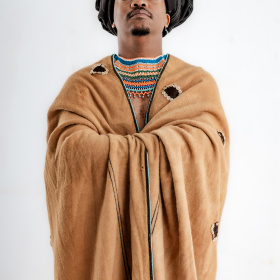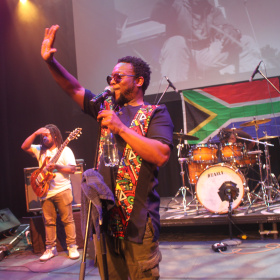Arts Education in D. R. Congo: Looking Back and Thinking Ahead
The author gives an overview of the musical, cultural and arts education starting with the Congolese tradition, through the colonial era, and to the present day. He also presents the future prospects of arts education.
 Source: www.filmsfix.com
Source: www.filmsfix.com
Arts education from the Belgian colonial era until the independence of Congo
The colonial era is known to have favored the promotion of African languages and traditions. In fact, ethnological, anthropological and ethnographic studies served first the needs of the European (Belgian) researchers and administrators. Those studies helped them understand the Bantu cultures and mentalities. We now know that initially, around the time when the first religious schools settled in the colony in the 20s, the Belgians published art works under Congolese pseudonyms. By doing so, they were showing that the blacks in the Belgian colony had “evolved”, compared to the "assimilés" of the French or Portuguese colonies. Examples of works created by Belgians include the first painting workshops and the first literary works such as the tale “L’éléphant qui marchait sur les œufs” (“the elephant who walked on eggs”) written by a mysterious Badibanga.
The first black artists and writers emerged much later in the 30s and 40s, particularly in music, theater and painting. The first known painting studios were started in Kinshasa and Lubumbashi. The major recording studios (Ngoma, Opika, Loningisa) were opened by Greek or Portuguese traders in Kinshasa. The first generation of Congolese artists includes Antoine Wendo, Kabasele Joseph (Grand Kalle), François Luambo (Franco), Nicolas Kassanda (Nico), Lucie Eyenga, Victor Longomba (Vicky). The first artists in the Dramatic Arts (theater, ballet, dance, and cinema) include Albert Mongita, Justin Dissassi, Ngombe Baseko Master (aka Maître Taureau) or Alexis Tshibangu.
Between the 40s and the 50s, thanks to sponsors such as “Amis de la vie indigène” (Friends of Indigenous Life), the popular arts took off in cultural centers or via popular shows touring the large cities. Arts and shows were so successful that an effort to formalize them was undertaken. In 1947, the Académie des Beaux–Arts (Academy of Fine Arts) was created by the Brothers of the Christian Schools.
This tradition of folk arts continued and even increased over time, and the music turned out to be the genre operated with the most genius and success. After the independence in 1960, the movement for the promotion of Negro cultural identities gained momentum. After the creation of the Festival des Arts nègres (Festival of Negro Arts) in Dakar in 1966, the Conservatoire National de Musique et d’Art Dramatique (CNMA, National Conservatory of Music and Drama) was created in Kinshasa in 1967 with the mission to train technicians and professionals at the secondary and tertiary levels. The creation of the institution contradicted the assertion that "emotion is Negro" and that all blacks, including Congolese, have a natural talent for music. Initially, the CNMA was inspired by European conservatories particularly that of Geneva from which Philippe Kanza Matondo the first director of CNMA graduated. Since its inception, the CNMA had been placed under the supervision of the Minister of Culture and Arts. In 1969, the Théâtre National Congolais (Congolese National Theatre) was created to offer employment opportunities to the professional CNMA graduates.
The Institut National des Arts (INA, National Institute of Arts) and the Mobutu era
In 1971, President Mobutu imposed a reform that merged all the universities and institutes of higher education into a single monolithic structure: the National University of Zaire (French: Université Nationale du Zaïre, UNAZA). The CNMA was integrated in UNAZA and thus was placed under the authority of the Ministry of Higher Education instead of the Ministry Culture. In 1973, the CNMA became the “National Institute of Arts”; its mission was educational (teaching, research, community service) with a particular focus on the revaluation of local arts. Instead of copying the European conservatories, the National Institute of Arts would use the fundamental principles of classical training to study and research the traditional knowledge and know-how in order to create and promote art in new and modern ways. In 1978 an entertainment section was added to the already existing music and theater section of the INA with the aim of training entrepreneurs and professional cultural managers.
In 1976 a research center called “Centre d’ Etudes et de Diffusion des Arts” (CEDAR or Center of Studies and Diffusion of Arts) was added to the INA in order to reinforce the 'research' dimension.
In order to keep up with the state-of-the-art knowledge and techniques, INA firstly consolidated its base at the secondary level via its "applied school" considered as its "nursery", the Institute for the Performing Arts (Institut des Arts du Spectacle-INAS). INA also ambitiously added a tertiary level to each of its departments and diversified the field of "dramatic arts" with theater, dance and film.
INA’s ambitions have proved to be a real challenge because the institution had to overcome the common stereotypes and prejudices against an artistic career often considered as “marginal” in the society. Furthermore, instructors had to be trained about popular dramatic and musical artistic traditions. In the field of music, learning methods, reading, composition and writing standards remain the same; the main areas are: 1) classical music, because it reinforces discipline and the respect of universal norms; 2) ethno musicological research, because it explores the forms and styles of our knowledge and endogenous expertise, and 3) Jazz music, because it gives room to creativity and fantasia. Dramatic Arts are mostly based on stage performance and interpretation. Nowadays, cultural animation is moving more and more towards entrepreneurship, cultural engineering, management, and promotion of cultural heritage.
Future prospects
Today, in 2013, INA is at a crossroads, as the artistic field becomes increasingly multidisciplinary. There are fewer boundaries between the performing arts and the visual arts or fashion, thanks to new forms of "performance", "visual communications" or choreographed exhibitions.
Projects are currently being discussed by experts including the creation of a synergy between modules of different institutes such as the Académie des Beaux-Arts (ABA or Academy of Fine Arts), the Institut Supérieur des Arts et Métiers (ISAM or Higher Institute of Arts and Crafts) and the Insitut Supérieur d’Architecture et de l’Urbanisme (ISA or Higher Institute of Architecture and Urbanism). Several common core curriculums are being planned in connection with the consolidation of professional practices. Other ideas include the implementation of aesthetics modules; the application of the new technologies of communication for the promotion of the tangible and intangible cultural heritage; the implementation of teaching methods using objectives and class projects; the support for in-depth knowledge of the Congolese history and traditions; the connection with workplace and the development of a national cultural policy...
In any case, the higher institutes of arts of the DRC are unique in Central Africa. However, they are still the orphan child of education policies, given the scarcity of government subsidies, the pressure of informal activities on the job market, the job insecurity, and the inadequacy of academic and pedagogical infrastructures.
The strengthening of the curriculums in order to adapt to the rapidly changing technology remains a challenge. Furthermore, to complement the existing specialized arts institutes, arts education should be integrated in the curriculum of general education at the secondary level. This integration is essential in order to instill artistic sensibility and common sense, and for awakening talents.
It is time for arts education in DR Congo to move from the informal realm and amateurism to become more professional and rational.
By Lye M. Yoka
Disclaimer: Music In Africa's Overviews provide broad information about the music scenes in African countries. Music In Africa understands that the information in some of these texts could become outdated with time. If you would like to provide updated information or corrections to any of our Overview texts, please contact us at info@musicinafrica.net.






















Comments
Log in or register to post comments